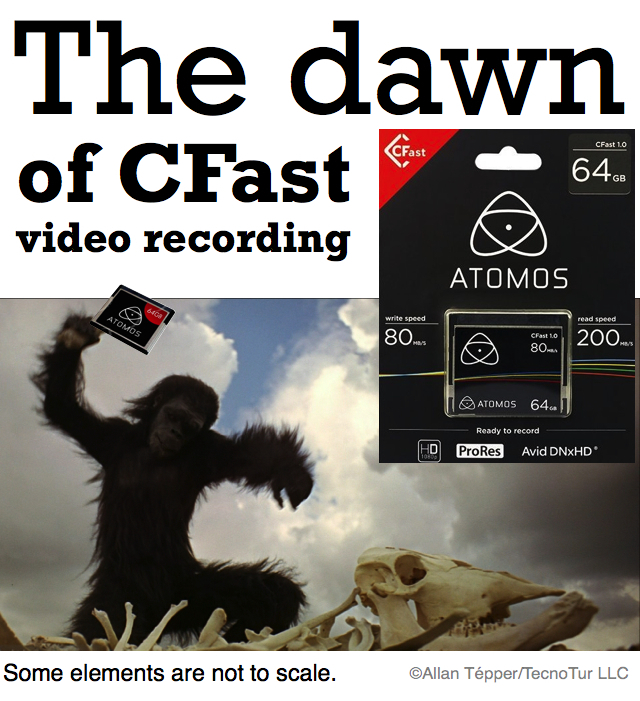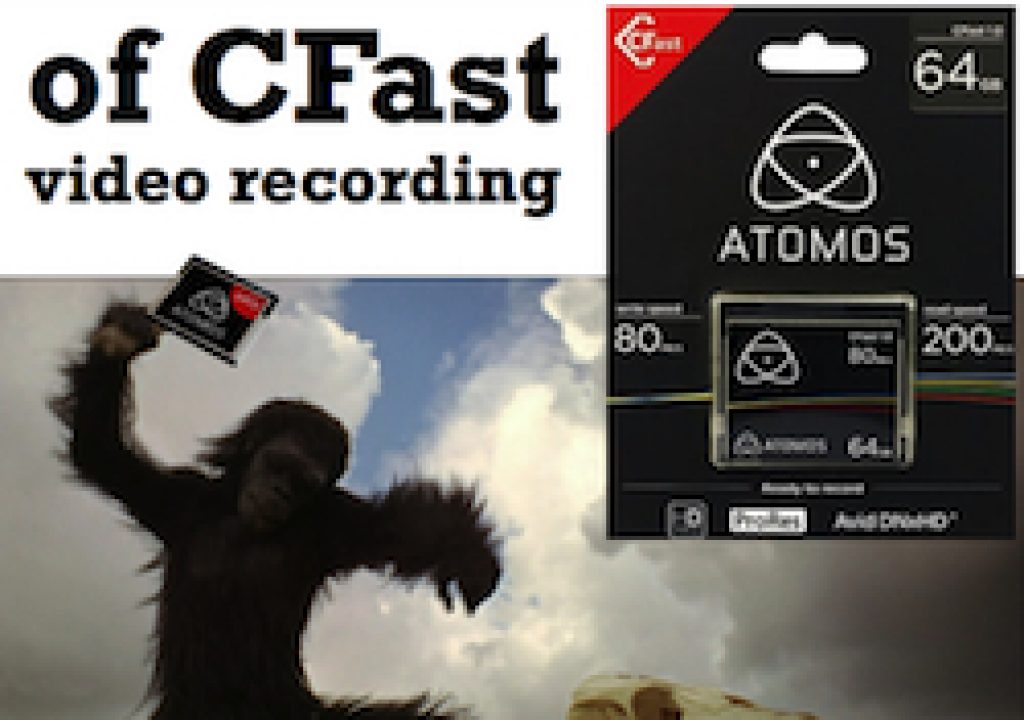
The first CFast devices were shown at CES in 2009, but NAB 2014 was the first time I saw professional video products using it. CFast is a derivative format of CompactFlash which offers the very high bit rates required by virtually lossless intraframe 10-bit 4:2:2 códecs like ProRes 422 and DNxHD for HD, and even for 4K. The pioneers I saw using it were Átomos and Blackmagic. A tiny CFast chip now rivals an HDCAM SR tape, and a US$50 CFast reader now rivals an HDCAM SR deck which typically costs well over US$50k. Ahead are the details.
To clarify my statement in the above paragraph: I am aware that Avid’s DNxHD offers both 8-bit and 10-bit, but I was referring to the 10-bit variety.
What’s so special about CFast recording?
CFast 1.0 products that are already available offer 80MB/s write speed and 200MB/s read speed. CFast 2.0 (required for 4K with the mentioned códecs) is currently achieving 450MB/s speeds. Initially, some readers might not be so impressed with those numbers, since traditionally these types of media cards and códecs have measured their speed it Mb/s (megabits per second) rather than MB/s per second). Actually, that even includes high-end digital videotape recording formats, including JVC’s D9 (previously called “Digital S”), Panasonic’s DVC Pro, Panasonic’s DVC Pro50, Panasonic’s DVCPro HD, Sony’s Digital Betacam, Sony’s HDCAM, and Sony’s HDCAM SR. Even the high-end tapeless formats from Panasonic (more recently, AVC-Intra 50 and AVC-Intra 100) and Sony (XDCAM HD and more recently, XAVC and XAVC S) have also been specified in megabits. Take those megabit per second numbers and divide them by eight, and you’ll discover that they are much lower when compared to the above MB (megabyte) per second numbers. Or, if you prefer to continue to work with megabit per second nomenclature, I’ll gladly translate the numbers from the first sentence of this paragraph: In Mb/s (megabit per second) terminology, CFast 1.0 products that are already available offer 640 Mb/s write speed and 1600 Mb/s read speed. CFast 2.0 (required for 4K) is currently achieving 3600 Mb/s speeds.
For pocket-sized, mass-market memory cards sold in a blister pack, we are officially no longer in Kansas!
Above is an example of a Sony HDCAM SR deck. The HDCAM SR format typically has a video bit rate of 440 Mbit/s, and a total data rate of approx. 600 Mbit/s. If I translate to MB, that works out to 55 MB/s and 75 MB/s respectively. HDCAM SR decks typically cost well over US$50,000.
Some pro video devices that use CFast
- Átomos Ninja Star US$299 1080p 4:2:2 10-bit recorder (I am currently testing it… Standby for the review.)
- Átomos Shogun 4K 4:2:2 recorder/monitor w/ balanced audio (I plan to test the Shogun both with the Panasonic Lumix GH4 and with the Sony A7s as soon as I receive it.)
- Arri Amira camera
- Blackmagic URSA camera
The above list is likely to be incomplete, but those are the ones I know about so far.
How do you read a CFast card into your computer?
Fortunately, you don’t have to spend over US$50,000 to read the CFast cards into your computer. The reader connects via USB 3.0 and costs about US$50. Oh, and one comes included with the US$299 Ninja Star recorder I am currently testing.
Upcoming articles, reviews, and books
Stand by for upcoming articles, reviews, and books. Sign up to my free mailing list by clicking here.
Si deseas suscribirte a mi lista en castellano, visita aquí. Si prefieres, puedes suscribirte a ambas listas (castellano e inglés).
My latest book (paperback + ebook)
My most recent book is available in two languages, and in paperback as well as an ebook. The ebook format is Kindle, but even if you don’t have a Kindle device, you can read Kindle books on many other devices using a free Kindle app. That includes iPad, Android tablets, Mac computers, and Windows computers. Although generally speaking, Kindle books are readable on smartphones like Androids and iPhones, I don’t recommend it for this particular book since it contains both color photos and color comparison charts. The ebook is also DRM-free.
In English:
In English, it is currently available in the following Amazon stores, depending upon your region:
- Amazon.com, for the US and other countries in the Americas that don’t currently have their own Amazon store, or anywhere if you simply prefer it
- Amazon.br for Brazil
- Amazon.ca for Canada
- Amazon.de for Germany
- Amazon.es for Spain pero a lo mejor lo preferirás en castellano, a continuación)
- Amazon.fr for France
- Amazon.in for India
- Amazon.it for Italy
- Amazon.co.jp for Japan
- Amazon.com.mx for México
- Amazon.co.uk for the United Kingdom
Or in your favorite bookstore by requesting ISBN–10: 1456310232 or ISBN–13: 978–1456310233.
En castellano:
En castellano, está disponible actualmente en las siguientes tiendas Amazon, según tu región:
- Amazon.com para EE.UU. y todas las Américas donde no existe ninguna tienda particular… o en cualquier parte si simplemente lo prefieres
- Amazon.com.br para Brasil
- Amazon.co.jp para Japón
- Amazon.de para Alemania
- Amazon.es para España
- Amazon.fr (Francia)
- Amazon.in para India
- Amazon.it para Italia
- Amazon.com.mx para México
- Amazon.co.uk para el Reino Unido
o en tu librería preferida al solicitar el ISBN–10: 1492783390 ó el ISBN–13: 978–1492783398.
Allan Tépper’s other books, consulting, articles, seminars & audio programs
Contact Allan Tépper for consulting, or find a full listing of his books, articles and upcoming seminars and webinars at AllanTepper.com. Listen to his TecnoTur program, which is now available both in Castilian (aka “Spanish”) and in English, free of charge. Search for TecnoTur in iTunes or visit TecnoTur.us for more information.
FTC disclosure
No manufacturer is specifically paying Allan Tépper or TecnoTur LLC to write this article or the mentioned books. Some of the other manufacturers listed above have contracted Tépper and/or TecnoTur LLC to carry out consulting and/or translations/localizations/transcreations. Many of the manufacturers listed above have sent Allan Tépper review units. So far, none of the manufacturers listed above is/are sponsors of the TecnoTur programs, although they are welcome to do so, and some are, may be (or may have been) sponsors of ProVideo Coalition magazine. Some links to third parties listed in this article and/or on this web page may indirectly benefit TecnoTur LLC via affiliate programs.
Copyright and use of this article
The articles contained in the TecnoTur channel in ProVideo Coalition magazine are copyright Allan Tépper/TecnoTur LLC, except where otherwise attributed. Unauthorized use is prohibited without prior approval, except for short quotes which link back to this page, which are encouraged!

